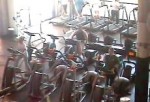Watching while you work out

Like a lot of students who work out on campus, Ahmad Ragab had no idea that anyone with an Internet connection could watch him while he exercises.
Four webcams on Student Government’s Web site, sg.usf.edu, show live feeds of Recreation Center activity. And there are no signs or other notification inside the gym that announce the presence of cameras.
“It seems like an invasion of privacy,” said Ragab, a graduate student who said he works out on campus three or four times a week. “People are in various states of dress, some with not a lot of clothes on.”
How they got there
The idea was brought up during Maxon Victor’s term as student body president in 2005. Having heard complaints about the crowded gym, SG decided to do something about it.
“I kept hearing complaints that we don’t have cameras,” said Kayla Munro, director of Marketing and Public Affairs for SG, who worked closely with the project. “People asked, ‘What if we just knew if equipment was being used?'”Members from SG then met with Campus Recreation Director Eric Hunter to start the process.
“I thought it was a great idea because so many people come from their dorms or their office and they arrive here only to see that (the gym) is packed,” Hunter said. “The idea is just to prevent unneeded trips.”
Four cameras – one aimed at cardiovascular machines, one in the weight room and one in each basketball court – were installed about a year ago but weren’t put online until this February because SG’s Web site had to be upgraded to handle the innovations.
The Recreation Center, which also has three additional offline cameras for security, paid a total of $10,063 toward the cameras. Using Activity and Service fees – money that each student pays as part of their tuition – SG paid a total of $8,690 for the cameras. ‘Could be a problem’
But some students feel it’s costing them more than their money.
“I could definitely see where some girls could see this as a problem,” said Phoebe Ray, a senior majoring in chemistry. “I wear comfortable clothes, so I don’t have a problem with it. But some people wear less.”
In defense, both SG and Hunter say that the resolution on the cameras doesn’t allow Internet users to make out the faces of people exercising, therefore making it safe and non-intrusive.
“We discussed this before we installed them,” Hunter said. “You might see colors, but not faces.”
The camera aimed at the cardiovascular machines is zoomed in much farther than the other three. An average student’s body is about one third as tall as the video window. This isn’t the case for the other three cameras, in which bodies are relatively tiny compared to their video windows.
“It’s really a pretty clear picture – you can get a good idea of what’s going on,” Hunter said of all four feeds. “But you cannot be identified.”
Signing up?
One problem some students had with the cameras is the lack of signs or notification inside the Recreation Center. “They should at least let us know,” Ragab said. “Why wouldn’t they just say, you know, ‘We’re doing this?’ Then people will at least know what’s going on.”
Hunter said it’s a good idea to put signs up.
“We really should,” he said. “There’s no law requiring it, but we should. It’s just been forgetfulness on our part.”
Colin Mailloux, USF associate general counsel, said that as far as he knew, nobody from SG or the Recreation Center sought advice from the USF Office of the General Counsel as to whether the cameras might raise legal questions.
“It’s something I suppose we might look into,” Mailloux said.






